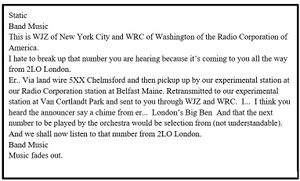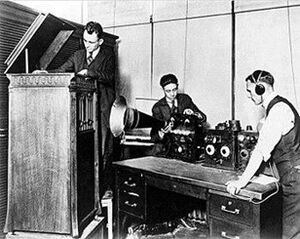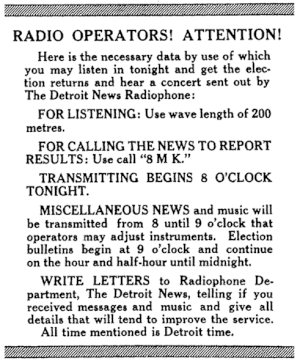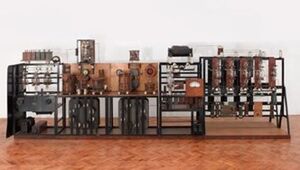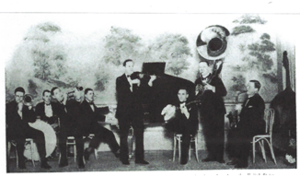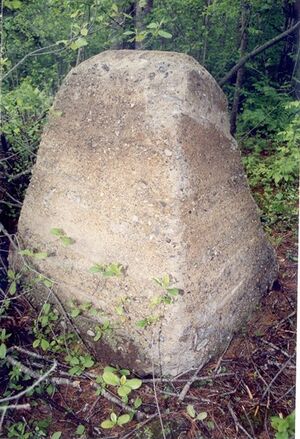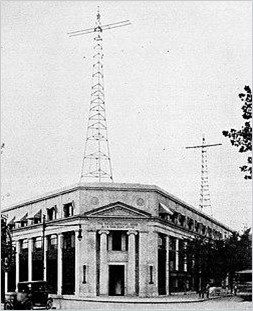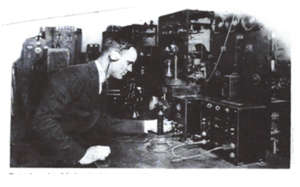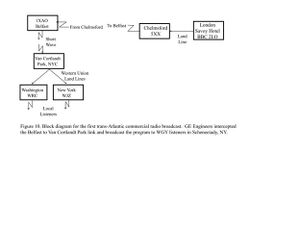Milestone-Proposal:First Live Commercial Trans-Atlantic Radio Broadcast
To see comments, or add a comment to this discussion, click here.
Docket #:2022-02
This proposal has been submitted for review.
To the proposer’s knowledge, is this achievement subject to litigation? No
Is the achievement you are proposing more than 25 years old? Yes
Is the achievement you are proposing within IEEE’s designated fields as defined by IEEE Bylaw I-104.11, namely: Engineering, Computer Sciences and Information Technology, Physical Sciences, Biological and Medical Sciences, Mathematics, Technical Communications, Education, Management, and Law and Policy. Yes
Did the achievement provide a meaningful benefit for humanity? Yes
Was it of at least regional importance? Yes
Has an IEEE Organizational Unit agreed to pay for the milestone plaque(s)? Yes
Has the IEEE Section(s) in which the plaque(s) will be located agreed to arrange the dedication ceremony? Yes
Has the IEEE Section in which the milestone is located agreed to take responsibility for the plaque after it is dedicated? Yes
Has the owner of the site agreed to have it designated as an IEEE Milestone? Yes
Year or range of years in which the achievement occurred:
1925
Title of the proposed milestone:
First Live Trans-Atlantic Commercial Radio Broadcast , 1925
Plaque citation summarizing the achievement and its significance; if personal name(s) are included, such name(s) must follow the achievement itself in the citation wording: Text absolutely limited by plaque dimensions to 70 words; 60 is preferable for aesthetic reasons.
On March 14, 1925 the first trans-Atlantic commercial radio was received at the Radio Corporation of America station in Belfast. Originated by the BBC at London’s Savoy Hotel, the signal was relayed to Washington and New York via Balfast where listeners heard the hotel’s dance band on their home radios. This broadcast was the forerunner of today’s global live broadcasts and global social media conversations.
200-250 word abstract describing the significance of the technical achievement being proposed, the person(s) involved, historical context, humanitarian and social impact, as well as any possible controversies the advocate might need to review.
One hundred years ago the holy grail of radio was long distance voice broadcasting -- a principal one being Trans-Atlantic. The early voice communication successes were more accidental happenstance by amateurs. Then, under the leadership of the Radio Corporation of America led by David Sarnoff and Marconi's Wireless Telegraph Company in the UK a well planned, system engineered attempt succeeded on March 14, 1925. A regularly scheduled BBC broadcast from London was broadcast live in New York and Washington to local listeners by NBC stations WJZ and WRC. This fulfilled a vision of Sarnoff and A. N. Goldsmith, RCA's Chief Broadcast Engineer as well as the BBC and Marconi. It was a game changer, the forerunner of today's routine live global broadcast news reporting and programming.
IEEE technical societies and technical councils within whose fields of interest the Milestone proposal resides.
Systems Council, Antennas and Propagation Society, Broadcast Technology Society, Communications Society, Society on Social Implications of Technology
In what IEEE section(s) does it reside?
Maine
IEEE Organizational Unit(s) which have agreed to sponsor the Milestone:
IEEE Organizational Unit(s) paying for milestone plaque(s):
Unit: IEEE Maine Section
Senior Officer Name: Julia Upton
IEEE Organizational Unit(s) arranging the dedication ceremony:
Unit: IEEE Maine Section
Senior Officer Name: Julia Upton
IEEE section(s) monitoring the plaque(s):
IEEE Section: IEEE Maine Section
IEEE Section Chair name: Julia Upton
Milestone proposer(s):
Proposer name: Ronald O. Brown
Proposer email: Proposer's email masked to public
Please note: your email address and contact information will be masked on the website for privacy reasons. Only IEEE History Center Staff will be able to view the email address.
Street address(es) and GPS coordinates in decimal form of the intended milestone plaque site(s):
10 Market St, Belfast, Maine USA; 44.426, -69.008
Describe briefly the intended site(s) of the milestone plaque(s). The intended site(s) must have a direct connection with the achievement (e.g. where developed, invented, tested, demonstrated, installed, or operated, etc.). A museum where a device or example of the technology is displayed, or the university where the inventor studied, are not, in themselves, sufficient connection for a milestone plaque.
Please give the details of the mounting, i.e. on the outside of the building, in the ground floor entrance hall, on a plinth on the grounds, etc. If visitors to the plaque site will need to go through security, or make an appointment, please give the contact information visitors will need. Since the RCA site no longer exists, the plaque will be located on the outside of the building housing the Belfast Historical Society, which houses an extensive exhibit of the event.e of the building Roadside plaque adjacent to site which included a 10 mile long Beverage antenna.
Are the original buildings extant?
Antenna gude blocks remain
Details of the plaque mounting:
It will be mounted on the front outside of the building.
How is the site protected/secured, and in what ways is it accessible to the public?
It will be mounted on the outside front of the building and visible from the street and sidewalk.
Who is the present owner of the site(s)?
The building houses the Belfast (Maine) Historical Society
What is the historical significance of the work (its technological, scientific, or social importance)? If personal names are included in citation, include detailed support at the end of this section preceded by "Justification for Inclusion of Name(s)". (see section 6 of Milestone Guidelines)
The technological and scientific significance of this event are::
* Under the executive direction of David Sarnoff, RCA’s engineers pushed the frontiers of radio antenna and receiver design. * The RCA, Marconi, and BBC engineers worked together to system engineer the multiple links required to transmit the broadcast live from London’s Savoy Hotel to listeners in Washington DC and New York, NY.
The social significance if this event are:
- In the form of music and the accompanying language monologue, this was the first transoceanic live audio sharing of a culture.
- Such cultural sharing is a fundamental building block of the world community which has become commonplace today.
What obstacles (technical, political, geographic) needed to be overcome?
- The technical/geographic obstacle that was overcome was the interoperability of the multiple relaying links over approximately 6000 kilometers with a channel that was sufficiently stable for a 3 hour broadcast of voice and accompanying band music to be clearly heard by radio listeners in their homes.
- Since radio was still in its infancy, there were no significant political obstacles to overcome.
What features set this work apart from similar achievements?
Significant distinguishing features are:
- International systems engineering between two countries (United States and the United Kingdom) comprising three entities (Radio Corporation of America as RCA was then known, British Broadcasting Company as the BBC was then known, and Marconi) plus the participation of Western Union for landlines in the United States.
- Multiple relaying using multiple technologies between London UK to Chelmsford to Belfast ME USA via long wave to van Cortlandt Park NY via HF radio to WJZ New York and WRC Washington DC via Western Union landlines which broadcast the program live to their listeners.
- Since General Electric engineers in Schenectady NY were aware of it they listened to the Belfast to van Cortlandt HF relay and broadcast it live to WGY Schenectady listeners.
- The project was deliberately planned to be the sharing of cultures. Thus it is the harbinger of today's global networking.
Why was the achievement successful and impactful?
Supporting texts and citations to establish the dates, location, and importance of the achievement: Minimum of five (5), but as many as needed to support the milestone, such as patents, contemporary newspaper articles, journal articles, or chapters in scholarly books. 'Scholarly' is defined as peer-reviewed, with references, and published. You must supply the texts or excerpts themselves, not just the references. At least one of the references must be from a scholarly book or journal article. All supporting materials must be in English, or accompanied by an English translation.
The First Trans-Atlantic Commercial Radio Broadcast --
Hello America!
…A milestone in radio progress. -- David Sarnoff(1)
…All the world rests upon the interchange of intelligence. -- David Sarnoff(2)
HISTORICAL SIGNIFICANCE
The historical significance of this event are:
- The first Trans-Atlantic commercial radio broadcast that occurred March 14, 1925.(3) The broadcast originated at London’s Savoy Hotel and aside from being broadcast to its regular UK listeners by the BBC it was relayed to US listeners in New York City, Washington DC, and incidentally in Schenectady NY.
- The first successful broadcast radio double relaying. Link 1 was long-wave from the UK to Belfast Maine; Link 2 was an HF radio link from Belfast Maine to New York. Link 2 was also copied by GE engineers in Schenectady NY and broadcast live to WGY Schenectady listeners.
- A very early example of complex systems engineering in radio broadcasting. The many radio and landline links were engineered by RCA, BBC, and Marconi and landlines were provided by Western Union.
- A very early example of deliberately developing technologies for societal change. RCA’s David Sarnoff and Alfred Goldsmith and BBC engineers clearly understood the societal importance of such a broadcast.
These four points clearly demonstrate that the first trans-Atlantic commercial radio broadcast deserves recognition as an IEEE Milestone. In fact, this last point demonstrates the IEEE’s tagline, Advancing Technology for Humanity.
Important too, the thorough research for this proposal resolves some claims and counterclaims about early radio history.
Explanatory Narrative
“Hello, America! This is the Hotel Savoy broadcasting from 5 Savoy Court, London, England, Station (BBC) 2LO”. So heard radio listeners in Washington DC, New York City, and Schenectady NY in the United States at about 6:15 PM on March 14th 1925.(1,4,5,6)) Thus began successful trans-Atlantic commercial radio broadcasting! Figure 1 is the transcription of a surviving 3 minute clip of this first broadcast.(7)
This event is technically significant because it was not only the first commercial trans-Atlantic radio broadcast, but it was a coordinated systems engineering effort between engineers from RCA, Marconi, and the BBC.
- Working together these engineers brought together the many technical elements necessary for a communication system to double relay the dance band in London so it was heard by commercial radio listeners in Washington, DC and New York, NY.
- Since the project was known to GE engineers in Schenectady, they too were able to rebroadcast it to listeners there by receiving the Belfast Maine to New York relay.(8,p9-11; 9,p22-23)
Equally important is the project’s social significance.
- Like today’s social media founding pioneers, RCA’s David Sarnoff understood media’s social importance and radio’s potential role in it. He recognized that radio, and later video/TV would beneficially change society.(10)
- Since Sarnoff enthusiastically supported these ventures, he was clearly an early adopter of what is now the IEEE’s credo of Advancing Technology for Humanity.
- Similarly, Dr. Alfred N. Goldsmith, RCA’s Chief Broadcast Engineer, Director of RCA’s Van Cortlandt Street Laboratories, ultimately IRE founder, Fellow, and past IRE President envisioned audio networks spanning the oceans.(8; 11p227-229)
- At the same time the British engineers realized the importance of long distance communications for the Empire so they too supported the project. The project was the forerunner of the BBC’s Empire Service begun in 1932.(12)
- Even before its demonstrated success, Sarnoff and Goldsmith and the BBC knew that this would be a societal game changer. It was the Internet and Facebook of its day!
- They weren’t the only ones who recognized radio’s social potential. In 1928 Radio Broadcast headlined Radio May Become the Cornerstone of the Amusement Industries.(13,p91) The article noted the relationships between the movie industry, phonograph industry, RCA, the Bell System, Movietone, General Electric. Today we still have similar relationship concerns.
Thus, the UK to US broadcast was not only proof-of-concept of long haul radio transmission for both parties; it was a societal game changer instituted by communications technology! Even while in the planning stage, Sarnoff, Goldsmith, and the BBC recognized it as such.
Leading up to this event:
- Considered the earliest trans-Atlantic reception was Marconi’s reception of the letter S sent from Cornwall to Newfoundland in 1901.(3)
- In the late 1910s while not in its infancy, broadcast radio was a preschool child.
- An early pioneer American Station was 1XE, later WGI, in Medford Hillside, MA. It began weekly music concerts in early 1916 and by spring 1920 was broadcasting several times a week.(14)
- In 1919 the Canadian Marconi Wireless Telegraph Company, later Canadian Marconi Company, launched XWA (for Experimental Wireless Apparatus). Extensive experiments were conducted by XWA before it was granted a regular license as CFCF in May 1920.(15) It began regular broadcasts on 1200 meters as XWA in December 1919 using a borrowed record player and records given by a local store in return for on-the-air mention -- thus introducing the concept of advertising to the airwaves. They also read news and weather forecasts from local Montreal papers. Some say CFCF stands for Canada’s First, Canada’s Finest!(16;17,p6-7; 18,p6; 19,p22; 20, 21)
- On October 17, 1919 with the active encouragement of the United States Navy and the active participation of General Electric with its radio patents, RCA was formed, largely out of American Marconi.(10) With its parentage, RCA in these early days had a cooperative relationship with GE’s and Marconi’s engineering staff.(10, 19.p15-17, 22)
- Regular wireless broadcasts for entertainment began in Argentina on August 27, 1920, pioneered by a group around Enrique Telémaco Susini. On August 27, 1920 they broadcast on 350 meters Wagner’s Parsifal from the Teatro Coliseo in Buenos Aires using a 5W transmitter, a Telefunken RS-5 tube and a wire antenna connected to the dome on a neighboring building.(23)
- 8MK Detroit, later WWJ, began broadcasting August 20th 1920 and on August 31st 1920 they broadcast the first known (at least in the United States) radio news program. Figure 2 shows part of their broadcast studio while Figure 3 shows a front page Detroit News ad for their new service.(14, 24a, 24)
- In 1920 General Electric and Marconi Company developed Britain’s first experimental station 2MT.(12)
- While Westinghouse’s engineer Frank Conrad had been broadcasting from his own station as 8XK since 1916, in October 1920, Westinghouse in Pittsburgh, Pennsylvania became the first US commercial broadcasting station to be licensed when it was granted call letters KDKA. On November 2, 1920, KDKA began licensed broadcasting with the results of the Harding-Cox US presidential election. KDKA has described itself as the "Pioneer Broadcasting Station of the World" tracing its beginning to Conrad’s temporarily assigned "special amateur" call sign of 8XK, to its broadcast of the 1920 Harding-Cox presidential election results.25, 26, 27) Others fiercely argue the validity of its claims of first, stating that it is more based on Westinghouse’s power of publicity.(14) What seems clear is that KDKA was the first licensed station in the US.
- There were estimated to be about 1000 listeners to the election results.(26) In that time frame wireless sets (radios) cost $10 in Pittsburgh, or about 18 hours work in a typical manufacturing job. There was a way to go before radio would be a part of mass media.
- Note: Like so many inventions, many around the world were working in the area, first is partially a matter of local, regional, and national.
- The next big US broadcast was WJY’s July 2,1921 broadcast of the Dempsy - Carpentier championship heavyweight boxing match in Jersey City. Some said that those who listened on their radio/crystal sets had a better description of the bout than on-site spectators.(10, 22,p22)
- In October 1922 the British Broadcasting Company (later Corporation) was formed and at 6:00PM on November 14, 1922 Arthur Burrows, Director of Programmes, says: “This is 2LO calling” from the seventh floor of Marconi House on the Strand, inaugurating national radio broadcasting in the United Kingdom. Figure 4 shows the original transmitter.(12)
- In 1923 H. H. Beverage and H. O. Peterson of RCA discovered that the 110 meter carrier and sidebands of KDKA faded in random fashion, suggesting multipaths. This led to their creation of space diversity reception.(10)
- In 1924 RCA introduced radios for home-use incorporating E. H. Armstrong’s superheterodyne circuit.(8) The low end model cost $224 or about 15% of the average family’s annual income!(28,29)
- By the mid-1920s there were hundreds of radio stations world-wide. Radio was taking off.(30)
- In the intervening times there were several successful attempts to cross the Atlantic Ocean and in 1923 human voice was transmitted from Manchester England to Pittsburgh PA. But these were not part of regular broadcasts.(3)
- There were also numerous of what the ARRL Heritage Museum calls trans-Atlantic Tests. Again, these were not regular commercial radio broadcasts.(31)
People clamored for news and entertainment from afar so the enticement of receiving a station from across the Atlantic Ocean was high priority -- the holy grail of early radio in North America and Europe. Of course, such signals would be extremely weak, well beyond the capability of the home receivers of the day. There were many early attempts, but reception was so poor they are not considered successful.
RCA's Belfast, Maine receiver station addressed this issue by combining a receiver with a 10-mile long Beverage or wave antenna.(8,22) Also, Belfast’s coastal location on the great circle route from New York to Europe received a stronger signal than RCA’s Riverdale Long Island location. From Belfast, a clearly received European signal could be re-transmitted, or relayed, to New York for rebroadcast.
According to E. V. Amy, RCA 1XAO Belfast’s Engineer-in-Charge,(33, 34,p5, 19) details of the Belfast receiver system are:
- Two Beverage antennas, each 52,610 feet, almost 10 miles, long and extending to Black Brook near Moody Mountain in East Searsmont, ME.
- One was located 8 miles from the site and required a specially built transmission line.
- While only twenty feet above the ground, the antennas have an effective height of 1,000 feet.
- The Belfast receiver was the standard high power receiver that RCA used at all its trans-oceanic receiving stations. It comprised a wave trap and two tuned circuits in front of a three-stage rf detector, and a two stage audio frequency amplifier.
The transmission system was a telephone transmitter operating at 1600 meters(34,p9; 35,p44-46; 36) with 15kW of power(37) which is fifteen times the power of WJZ and WJY.
Important side notes are:
- Of particular interest to the IEEE is that 1XAO Belfast was a link in a chain of stations that IRE Founder Dr. Alfred N. Goldsmith envisioned to span the Atlantic with voice and music.
- Originally the Belfast station was licensed in 1920 as 1XR to the International Radio Telegraph Company for ship-to-shore use. RCA acquired the 400 acre facility in September 1921 and the station was licensed to RCA in 1923 as 1XAO.(8,36,38,39)
- RCA built-up its engineering staff during this time and radio experiments began in 1923. Regular staff included L. B. Smith from Marconi, regular RCA employees, and visits from wave antenna inventor Harold Beverage.(40) It is noted that RCA used the term engineer very loosely. Some had little or no formal engineering training.(41)
- The importance of the Belfast location at that time to RCA is demonstrated by the visit to Belfast by David Sarnoff and his wife in October 1921.(42)
- A late evening broadcast from London corresponds with an early evening reception in eastern United States, thereby taking advantage of the then well-known enhanced evening transmission characteristics.
Specifics of this proposed March 14, 1925 milestone are:
- After earlier unsuccessful attempts, including just nights earlier,(43, 44) a broadcast of a dance band playing American jazz including 'Alabamy Bound'(45) at the Savoy Hotel was carried by wire to BBC station 2LO in London on March 14,1925.(3)
- The specific program broadcast at 10:30 (local time) was a regularly scheduled BBC program, The hotel band at the time of the broadcast is shown in Figure 5.(8,p9-11)
- It was also then carried by landline to station 5XX Chelmsford UK(3) for broadcast by long wave, 1600 meters with an aggregate power of 25,000 watts.(46, 47)
- The transmitter antenna at Chelmsford was supported by two 450 foot steel masts and the master oscillator circuit provided by Marconi had four large valves and operated at a potential of 9,000 volts.(9, 48, 49)
- RCA’s receiver facility in Belfast Maine used a 10 mile long Beverage antenna that was highly directive.(47)
- The Belfast receiver was the standard receiver used by RCA at its transoceanic receiving locations. It comprised a wave trap, in front of a two stage audio frequency amplifier. Figure 6 shows RCA’s Belfast relay station,(34, 49) while Figure 7 shows the remains of an antenna mooring block.(50)
- From 1XAO Belfast(3) it was transmitted by short wave, 120 meters(36) to RCA’s experimental station and radio test laboratory in Van Cortlandt Park, New York.(8, 10)
- Then it was sent from Van Cortlandt Park over Western Union landlines to US stations WJZ(34) in New York and WRC in Washington, DC(3, 8, 36,40) for broadcast to their listeners on wavelengths of 455 and 46 meters respectively. Figure 8 shows the WRC antenna 150’ above the street(51) on the Riggs National Bank and Figure 9 shows the WJZ control room at the time of the broadcast.(8)
- Among the listeners was RCA’s David Sarnoff at his home in Mt Vernon, NY who said, “Progress in joining continents by radio in this manner has come more rapidly than we had dared to expect. Listening-in at a country home to concerts in London is an experience which will live in the memory of thousands and marks a milestone in radio progress. The people of the United States have received a new gift from radio…”(1, 3)
- Figure 10 shows a high level systems block diagram of the accomplishment.
- Some state that this first broadcast was from the BBC’s 5XX in Daventry, not Chelmsford.(45) However, since Daventry did not open until 1929, this claim is not possible.(5, 12)
- The Belfast transmission to Van Cortlandt Park was also received at General Electric’s WGY Schenectady from which rebroadcast it to its area listeners.(8)
- Heard as an insert to the broadcast was Milton Cross, later the long time announcer for the Metropolitan Opera, explaining the distant origin of the program and giving a point-by-point description of the transmission from London to listeners in Washington and New York.(3)
Additional detail reported in the weekly Belfast ME Republican Journal include:(35)
- The gong of the world’s largest clock Big Ben was heard by listeners,
- Other selections heard were Moonlight and You, and The Stars and Stripes Forever, and
- The program closed with “This is England saying good night to America.”
HISTORICAL TECHNOLOGICAL, SCIENTIFIC, AND SOCIAL SIGNIFICANCE OF THE WORK The technological and scientific significance of this event are::
- Under the executive direction of David Sarnoff, RCA’s engineers pushed the frontiers of radio antenna and receiver design.
- The RCA, Marconi, and BBC engineers worked together to systems engineer the multiple links required to transmit the broadcast from London’s Savoy Hotel to listeners in Washington DC and New York, NY.
The social significance if this event are:
* In the form of music and the accompanying language monologue, this was the first transoceanic live audio sharing of a culture. * Such cultural sharing is a fundamental building block of the world community which has become commonplace today.
. EXPLANATORY NARRATIVE The successful March 14, 1925 reception in the United States of a broadcast originating in the United Kingdom is an example of what we today call great systems engineering. Engineers on both sides of the Atlantic deliberately and carefully designed, assembled, and configured available and appropriate equipment to carry a regularly scheduled London broadcast to home listeners’ receivers in the United States. This systems engineering required a total of five transmission links, plus the more incidental link to WGY Schenectady and its listeners. These are:
- BBC’s station 2LO London to broadcast the program from the Savoy Hotel.
- The broadcast to be carried by wireline from London to the overseas broadcast station 5XX in Chelmsford, England.
- The signal to be broadcast using long wave from Chelmsford over the Atlantic Ocean.
- The received signal to be received by the Beverage (Wave) antenna and associated receivers at RCA’s receiver facility in Belfast, Maine.
- For this signal to be rebroadcast by short wave by 1XAO, Belfast to an experimental receiver in Van Cortlandt Park, New York and also picked up at WGY in Schenectady.
- For Western Union landlines to carry the signal to WJZ New York and WRC Washington, DC for real time broadcast to listeners.
Importantly too, when the RCA’s New York engineers saw that the signal from 2LO was sufficiently good they interrupted their regular program to broadcast it.
In doing so, RCA, Marconi, and BBC engineers, as project leads, coordinated their efforts to overcome the technical obstacles of distance with transmitter power at Chelmsford, receiver sensitivity at Belfast, and antenna directivity and gain at both Chelmsford and Belfast as well as well-engineered links within England and the USA. Engineering these multiple links was a significant feat of systems engineering.
The historical social significance of the work was most succinctly stated by David Sarnoff: “…Listening-in at a country home to concerts in London is an experience which will live in the memory of thousands and marks a milestone in radio progress. The people of the United States have received a new gift from radio. The culture and music of London have come to them through the air.” As the leader of an engineering oriented company Sarnoff’s statement clearly shows that he and RCA fully understood the social and technical importance and potential long term impact of this broadcast. At the time it was the ultimate social demonstration of the radio music box that Sarnoff proposed in 1916 to E. J. Nally General Manager of the Marconi Wireless Telegraph Company of America. On the political side, radio was still just beyond infancy so there was limited political interest, much less direct political involvement in this important event. Politicians were not significantly involved, and the BBC’s pioneering Empire Service did not begin until 1932.
WHAT FEATURES SET THIS WORK APART FROM SIMILAR ACHIEVEMENTS?
The features which set this work apart from similar achievements are
- This event was not only the first live transoceanic commercial radio transmission with clarity of human voice, accompanied by music, and occuring for an extended period of time, but it also used double relaying to reach listeners. Earlier transoceanic information transmissions were telegraphic, or were brief and highly experimental in nature – many of these were by amateur radio operators.
- Human voice and music communications enables the ready and rapid communication of human emotion as well as the information. Telegraphic communications provides very slow communication of information and contains very little human emotion.
EXPLANATORY NARRATIVE
While radio-telegraph messages were first sent across the Atlantic Ocean on December 12, 1901 and there were prior attempts to transmit audio, this event was the first sustained reception with clarity. Thus, the technical ability to share culture in real time across thousands of miles was first demonstrated in this project.
Today without a second thought, we routinely listen to live radio and television broadcasts from the other side of the world. Individuals and businesses routinely use Skype, FaceTime, WebEx, Zoom, etc., to personally communicate.
This proposed milestone of the first trans-Atlantic Commercial Radio Broadcast was the harbinger of things to come. It was a cultural and sociological game changer! For the broadcast industry and society in general, it was the mother of them all!
ACKNOWLEDGEMENTS
This work would not have been possible without the support of many others. Specific thanks are due to:
- Antique Wireless Association for several contributions including the clip of the original broadcast.
- Bruce Clark for his earlier research which he so generously contributed.
- Denis Couillard of Ultra Electronics TCS in Montreal which is the successor to Canadian Marconi/Marconi Wireless Telegraph Company of Canada who provided me information regarding XWA’s later CFCF’s early history including copies of 'Manitoba Calling'.
- Donald N. Cox, Maine IEEE Section member, did significant research in Belfast at the Belfast Journal Republican and Belfast Historical Society and provided me the results of this work.
- Richard Gross who provided me with the entry to the National Registry.
- Hagley Museum and Library of Wilmington DE and specifically Angela Schad, Reference Archivist and Digital Archives Specialist who provided me information from their files
- Professor Donna L. Halper Associate Professor of Communication and Media Studies at Lesley University, Cambridge MA who pointed me to many resources including her own research.
- Professor David Kotecki of the University of Maine did significant earlier research into the broadcast and provided me the results of it.
- Mackenzie Libby an electrical engineering student at the University of Southern Maine who reviewed Clarence Hansell’s 70+ pages of handwritten design notes and condensed it into a series of factoids useful in preparing this proposal. These notes are from the Belfast station log and dated March 17, 1924.
- Harold E. Nelson of the Maine Department of Transportation who did much boots on the ground research about the Belfast facility and provided me with such information.
- Megan Pinette, President of the Belfast (ME) Historical Society and Museum, who provided me with a plethora of documentation from the museum’s collection about the broadcast and especially the RCA Belfast site.
I apologize to those whom I inadvertently omitted from this list.
Supporting materials (supported formats: GIF, JPEG, PNG, PDF, DOC): All supporting materials must be in English, or if not in English, accompanied by an English translation. You must supply the texts or excerpts themselves, not just the references. For documents that are copyright-encumbered, or which you do not have rights to post, email the documents themselves to ieee-history@ieee.org. Please see the Milestone Program Guidelines for more information.
END NOTES 1 New York Times, March 15, 1925. 2 Belfast Republican Journal, August 2, 1923. 3 Cary O’Dell. Motion Picture, Broadcast and Recorded Sound Division of the Library of Congress. Added to the National Registry, 2007. 4 The Bangor Daily News, Morch 16, 1925. 5 June 19, 2019 private email from Anne Locker, Library and Archives Manager, the Institution of Engineering and Technology. 6 Belfast Republican Journal. March 19, 1925. From Republican Journal excerpts provided by the Hagley Library, Wilmington DE. hagley.org 7 Audio clip provided by the Antique Wireless Association. 8 Wireless Age. May 25, 1925. London Talks to the U.S. J. Eddy. 9 World Wide Wireless. pp 22-23. undated copy. 10 Pioneering in Electronics: A Short History of the Origin and Growth of RCA Laboratories, Radio Corporation of America, 1919 - 1964, Chapter 1. Kenyon Kilbon. 1964. http://www.davidsarnoff.org/kil-chapter01.html. 11 Radio Broadcast Vol 14-4, February 1929, pp 227-229. Dr. Alfred N. Goldsmith: A Figure in Radio Progress by Edgar H. Felix. 12 From Marconi and the transistor to DAB: the history of radio in the UK. Hannah Bouckley. http://home.bt.com/tech-gadgets/internet/broadband/from-marconi-and-the-transistor-radio-to-dab-the-history-of-radio-in-the-uk-11364015764901. Downloaded Feb 12, 2018. 13 Radio Broadcast, December 1928. p91. 14 Broadcasters’ Desktop Resource. When Broadcasting Really Began, Refuting the KDKA Myth (Again), Dr. Donna L. Halper. https://www.thebdr.net/articles/prof/history/DiggingTruth.pdf. 15 Canada’s First Station Goes off the Air http://www.canada.com/news/Canada+first+radio+station+goes/2501424/story.html. 16 Private correspondence from Denis Couillard, Director Government Strategy, Ultra Intelligence and Communications, successor to Marconi Wireless Telegraph Company. February 11, 2020. 17 Manitoba Calling, Adventures in Radio - 14; Early Days of Canadian Broadcasting, D. R. P Coats, Vol 4, No 10, November 1940. 18 Manitoba Calling, Adventures in Radio - 15; Early Days of Canadian Broadcasting, D. R. P Coats, Vol 4, No 11, November 1940. 19 Note: The First 25 Years of RCA: A Quarter Century of Radio Progress. p22. Radio Corporation of America, New York, 1944 states that WEAF New York on September 7, 1922 had the first commercials. The charge was $100 for 10 minutes. Perhaps they did not know about XWA/ CFCF or they did not consider XWA/CFCF’s bartering a form of paid advertising. Downloaded from: https://books.google.com/books?id=IrkeAAAAIAAJ&q=rca+belfast+maine+radio+station&dq=rca+belfast+maine+radio+station&hl=en&sa=X&ved=0ahUKEwiD3_HA8YPcAhVHQ6wKHfvmAQoQ6AEIPDAE This URL is no longer available, but I have a copy on my computer. 20 https://www.broadcasting-history.ca/listing_and_histories/radio/cfcf-am, downloaded September 26, 2019. 21 https://en.wikipedia.org/wiki/List_of_oldest_radio_stations. 22 The First 25 Years of RCA: A Quarter Century of Radio Progress. Chapter 1. Radio Corporation of America, New York, 1944. http://www.davidsarnoff.org/kil-chapter01.htm. 23 https://en.wikipedia.org/wiki/Enrique_Tel%C3%A9maco_Susini. 24 https://en.wikipedia.org/wiki/WWJ_(AM). 24a WWJ Beginings.T. J. Wilkins. 2015 25 Note that Wikipedia says in one place (https://en.wikipedia.org/wiki/KDKA_(AM)) that KDKA’s initial call sign was 8ZZ but KDKA’s own history makes no mention of this. 26 It Started Hear. https://www.americanradiohistory.com/Archive-Station-Albums/It-Started-Hear-KDKA.pdf. 27 https://en.wikipedia.org/wiki/KDKA_(AM) 28 https://en.wikipedia.org/wiki/Superette_(radio) 29 Cost of Living in the United States ... May, 1924 : Bulletin of the United States Bureau of Labor Statistics, No. 357. https://fraser.stlouisfed.org/title/cost-living-united-states-may-1924-3997. 30 Radio in the 1920s. http://xroads.virginia.edu/~ug00/3on1/radioshow/1920radio.htm 31 The Historians View. The ARRL Heritage Museum. Chapter 5. Revised 5/1/2017. 32 The Beverage antenna was named for Harold Beverage, a 1915 University of Maine Electrical Engineering graduate. In 1920 he was placed in charge of transoceanic communications at RCA in Riverhead LI. 33 Lewiston Sun Journal. July 20, 2004. 34 Belfast Republican Journal. August 29, 1925. 35 The Radio Relay Station of the Radio Corporation of America at Belfast Maine, Bruce Clark. From the collection of the Belfast Historical Society. Used with permission. 36 Private Email from Cris Onan AV Archivist, AWA Museum. 37 A Broadcast History Through 1945. Jerome S. Berg states the power to be 25kw. 38 Wireless Age Vol 12, No 8. London Talks to U.S, J. Eddy, May 1925 reports the Belfast call sign as 1AOL. Since all other references to the Belfast station are to 1XAO and the keyboard proximity of O and L, it is believed that this is a typographical error. 39 US Department of Commerce. FCC Audio Division Scanned Document Access, July 1923. p5. 40 Belfast Republican Journal. March 4, 1923. 41 It should be noted that the word engineer is loosely used. One person was a wood cutter who was promoted to engineer because he knew Morse code and was clever! 42 Belfast Republican Journal, October 6, 1921 From Hagley Library, Wilmington DE. hagley.org. 43 Belfast Republican Journal, Belfast Republican Journal, March 13, 1925. . 44 New York Times, March 13, 1925. 45 Radio Archaeology, Dave Piszcz. Belfast Republican Journal, June 5, 2005. From Hagley Museum, Wilmington, DE 46 Wireless Age, Vol 12, No 8, London Talks to U.S. J. Eddy 47 Note: Listening to history speak. Jay Davis in the Citizen March 16, 2005 states the power was 20,000 watts. Belfast Republican Journal. 48 Private email dated November 7, 2019 from Sean Vis, Archivist, Archive Centre, BBC Written Archives, , Caversham Park, Reading England, RG4 8TZ. 49 Radio Digest. Link to Library of Congress copy provided by Hagley Library Wilmington, DE. hagley.org. https://archive.org/details/radi19251131519251926radi/page/n23/mode/2up2LO 50 Listening to history speak. Jay Davis in the Citizen March 16, 2005 states the power was 20,000 watts. 50 Photo by Harold E. Nelson. 51 Belfast Republican Journal. August 29, 1925. 52 Belfast Creative Coalition. https://belfastcreativecoalition.org/the-wave-catcher//. 53 WTEM https://enwikipedia.org/wiki/WTEM. Downloaded August 20, 2021
Please email a jpeg or PDF a letter in English, or with English translation, from the site owner(s) giving permission to place IEEE milestone plaque on the property, and a letter (or forwarded email) from the appropriate Section Chair supporting the Milestone application to ieee-history@ieee.org with the subject line "Attention: Milestone Administrator." Note that there are multiple texts of the letter depending on whether an IEEE organizational unit other than the section will be paying for the plaque(s).
Please recommend reviewers by emailing their names and email addresses to ieee-history@ieee.org. Please include the docket number and brief title of your proposal in the subject line of all emails.
